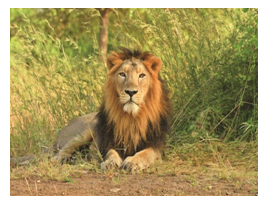

10th August 2023 (6 Topics)
Context
World Lion day is celebrated on 10 August annually to raise awareness about their conservation and protection.
Background
- World Lion Day was first established in 2013 by Big Cat Rescue, the world’s largest accredited sanctuary dedicated to lions, which recognised the need to draw attention to the declining lion populations and the threats they were facing in the wild.
- Later in 2013, they began the initiative to bring together both National Geographic and the Big Cat Initiative under a single banner to protect the remaining big cats livingin the wild and since then, World Lion Day is observed annually on August 10 to raise awareness about the conservation issues faced by the lions and to celebrate the beauty and significance of these iconic big cats.
About
About World Lion Day:
- Objective: The day serves as a platform to educate people about the challenges faced by the lions across the world and to promote efforts to conserve them as well as to celebrate these majestic big cats and their significance in ecosystems and cultures around the world.
- Need for conservation: There is an urgent need for their conservation hence; the day aims to educate people about the importance of lions in ecosystems and their cultural significance.
- Significance:World Lion Day plays a vital role in rallying support and action to ensure a future for these remarkable animals in the wild by shining a spotlight on lions and their conservation needs.
Lions in India:
- The Asiatic lion, also known as the Persian lion, is a population of Pantheraleothat today survives in the wild only in India.
- Since the turn of the 20th century, its range has been restricted to Gir National Park and the surrounding areas in the Indian state of Gujarat.
- The rarest lion is the Asiatic lion.
- It is a subspecies of lion found only in the Gir Forest of India.
- Protection Status:Asiatic lions are listed as endangered with only around 500 individuals remaining in the wild.
|
Types of Lion:
|
Why they need conservation?
- Lions are top predators in their environment, mostly found in grasslands, desert or open woodland.
- It means they play a crucial role in keeping a healthy balance of numbers among other animals, especially herbivores like zebra and wildebeest – which in turn influence the condition of grasslands and forests.
- By protecting a lion’s landscape, we can benefit wildlife but the people who rely on local natural resources too.
|
Gir National park:
|
Conservation efforts in India:
- Conservation efforts for Asiatic Lion were made for the first time in the year 1910.
- The Nawab of Junagadh imposed a ban on the hunting of lions within the boundaries of his province.
- The ban was continued even when India gained independence in 1944.
- Presently, Kuno Project is being undertaken with a view to reduce the overcrowding at Gir.
- Conservationists are trying to develop Kuno Wildlife Sanctuary, situated in Madhya Pradesh, into a natural habitat for the Asiatic lions.
- The Asiatic Lion Reintroduction Project is an Indian Government initiative to protect Asiatic lions by means of reintroducing them.
- This project is also known as the lion project in India and was introduced in 2004. Since then, the population of the Asiatic lion has increased considerably in the last few decades.
Threats:
- Human-Animal conflict: One of the major threats that the Indian lions are facing is the hostility they suffer at the hands of humans living near the sanctuary.
- It has become necessary to involve people in the conservation efforts being planned for the Indian lions.
- Increasing Deforestation: There are increasing instances of decline in the grasslands and savannah areas of Gir which affects their habitat.
Suggestive measure:
- A step that needs to be taken in this regard is to include the local residents within the field staff of the Gir Protected Area.
- It will not only sensitize people about the majestic species, but also educate them about the need to protect the species from extinction.
- At the same time, efforts should be undertaken to relocate as many humans out of the protected area of Gir as possible.



